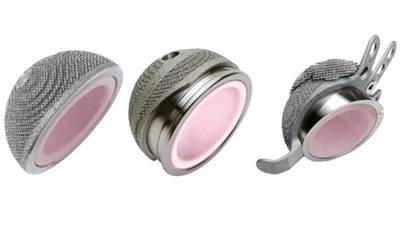Stryker Using Additive for Implants
Using its “AMagine” process, Stryker creates components with a titanium alloy that mimics bone.
Some of the most complex manufacturing routinely performed is devoted to producing orthopaedic devices for implantation. One of the companies that has long had a leadership position in this area — and “long” is no exaggeration, as the company was founded in 1941 — is Stryker.
The Stryker Monterey AL Interbody System is produced with the company’s proprietary powder bed fusion system. Called “AMagine,” Stryker produces implants that have a porous matrix that mimics cancellous bone. During a surgical procedure, the surgeon inserts the cage, which is produced with additive, that holds the cam locks (the gold elements). The three screws are inserted through the cage and into the vertebral bodies. Then the cam locks are rotated to secure it in place.
Photo Credit: Stryker
To produce implants that are not only geometrically accurate but which are made of material that mimics the porous structure of the cancellous bone such as in spinal applications, Stryker not only developed a proprietary material process, but proprietary hardware and software to additively make the components.
For example, at the recent North American Spine Society annual meeting, Stryker introduced the Monterey AL Interbody System. It is an anterior lumbar cage. It is primarily produced with a powder bed fusion system that was built to Stryker specs.
Stryker calls its additive manufacturing process for implants “AMagine.” The company has been working in the AM field for more than 10 years and says that the process they developed for making surgical implants “enables the creation of previously difficult or impossible product designs.”
Titanium Alloy Powder Deployed
One of the fundamental differences developed at Stryker for its additive application is what it calls “Tritanium In-Growth Technology.”
It is based on titanium alloy powder.
The titanium alloy produces parts that are strong, stiff and, importantly, biocompatible.
Like Bone in Structure
But then there is an important characteristic of the AMagine process: it allows the creation of structures that mimic cancellous bone. Cancellous bone is, comparatively speaking, “spongy.” More than achieving a surface geometry conducive to bone attachment, Stryker’s AMagine achieves cancellous-like porosity in the implant material.
The average porosity of the bone is ~50 to 90%. The average pore diameter is 600 µm. Stryker’s process gets to this in the implant material by randomizing metal powder grain sizes.
With the Tritanium material Stryker is able to build components that have an interconnected structure and randomized pore sizing through the size range from 100 to 700 µm (mean size: 400 to 500 µm), resulting in a mean porosity of from 55 to 65%.
Simply: the Tritanium component is cancellous bone-like in its structure, which facilitates osteogenic activity (a.k.a., bone building). According to Stryker, the porous structure is a “randomized yet reproducible.”
More AM Implants:
A mandibular cage made up of two different bioresorbable ceramics points to the future of bone graft and reconstructive surgeries in this episode of The Cool Parts Show.
See a titanium 3D printed spine implant with an unusual lattice structure in this episode of The Cool Parts Show.
Not an orthopedic implant, but this ice 3D printing method could be used to recreate vasculature for artificial organs and tissues.
Related Content
New Zeda Additive Manufacturing Factory in Ohio Will Serve Medical, Military and Aerospace Production
Site providing laser powder bed fusion as well as machining and other postprocessing will open in late 2023, and will employ over 100. Chief technology officer Greg Morris sees economic and personnel advantages of serving different markets from a single AM facility.
Read MoreFormlabs Part Removal Mechanism Enables Lights-Out Production
A build platform overcoming the need for manual part removal enables automated part handling, and therefore continuous production from one build cycle to the next.
Read MoreUnderstanding PEKK and PEEK for 3D Printing: The Cool Parts Show Bonus
Both materials offer properties desirable for medical implants, among other applications. In this bonus episode, hear more from Oxford Performance Materials and Curiteva about how these companies are applying PEKK and PEEK, respectively.
Read MoreZeda AM Production Plant in Ohio Now Open — Thoughts on the New Facility
73,000-square-foot metal powder bed fusion plant includes extensive machining capability plus separate operational models for serving medical versus other businesses.
Read MoreRead Next
How a 3D-Printed Metal Ankle Implant Replaces an Entire Bone
Through a novel surgery involving a 3D-printed talus bone, surgeons at the University of Miami found success — and unexpected challenges — with a patient suffering from sickle cell disease.
Read More10 Years Producing Hip Implants Through AM
There is already heritage in additive manufacturing. AM is taken seriously today in part because early users such as Lima Corporate have proven it.
Read MoreTopology Optimized 3D Printed Spine Implant: The Cool Parts Show #2
Medical contract manufacturer Tangible Solutions shares a titanium 3D printed spine implant with an unusual lattice structure in this episode of The Cool Parts Show.
Read More
.jpg;width=70;height=70;mode=crop)





















